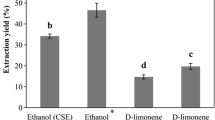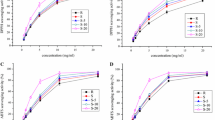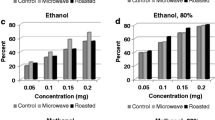Abstract
We investigated the contents and compositions of bioactive compounds in by-products of rice as affected by extraction with different solvents. Free and bound phenolic compounds and their antioxidant activities of rice bran and husk extracted by acetone, ethanol, and water at different temperatures (50, 60, 70, and 80 °C) were evaluated. Overall, the heated water extract provided the highest 2,2-diphenyl-1-picrylhydrazyl radical scavenging activities, ferric-reducing antioxidant power, total phenolic content, and total flavonoid content compared to the other solvents of all the samples studied. The antioxidant activities increased when the water temperature increased from 50 to 70 °C but decreased at 80 °C. The contents of bound phenolics were greater than those of free phenolics, including phenolic acids and flavonoids, in all the samples studied. Acetone gave the highest amounts of γ-oryzanol and tocopherols in all samples. With a reduction in particle size of the rice husk, there was a significant increase in extracted phenolic acids, flavonoids, and antioxidant properties.

Similar content being viewed by others
References
Abate A, Yang G, Wong RJ, Schroder H, Stevenson DK, Dennery PA (2005) Apigenin decreases hemin-mediated heme oxygenase-1 induction. Free Radic Biol Med 39:711–718
Abu Bakar MF, Mohamed M, Rahmat A, Fry J (2009) Phytochemicals and antioxidant activity of different parts of bambangan (Mangifera pajang) and tarap (Artocarpus odoratissimus). Food Chem 113:479–483
Adom KK, Liu RH (2002) Antioxidant activity of grains. J Agric Food Chem 50:6182–6187
Al-Farsi M, Lee CY (2008) Optimization of phenolics and dietary fibre extraction from date seeds. Food Chem 108:977–985
Alu’datt MH, Alli I, Ereifej K, Alhamad MN, Alsaad A, Rababeh T (2011) Optimisation and characterisation of various extraction conditions of phenolic compounds and antioxidant activity in olive seeds. Nat Prod Res 25:876–889
Antolovich M, Prenzler P, Robards K, Ryan D (2000) Sample preparation in the determination of phenolic compounds in fruits. Analyst 125:989–1009
Ballard TS, Mallikarjunan P, Zhou K, O’Keefe SF (2009) Optimizing the extraction of phenolic antioxidants from peanut skins using response surface methodology. J Agric Food Chem 57:3064–3072
Benzie IFF, Strain JJ (1996) The ferric reducing ability of plasma as a measure of ‘‘antioxidant power’’ the FRAP assay. Anal Biochem 239:70–76
Brewer LR, Kubola J, Siriamornpun S, Herald TJ, Shi Y (2014) Wheat bran particle size influence on phytochemical extractability and antioxidant properties. Food Chem 152:483–490
Bunzel M, Allerdings E, Sinwell V, Ralph J, Steinhart H (2002) Cell wall hydroxycinnamates in wild rice (Zizania aquatica L.) insoluble dietary fibre. Eur Food Res Technol 214:482–488
Butsat S, Siriamornpun S (2010) Antioxidant capacities and phenolic compounds of the husk, bran and endosperm of Thai rice. Food Chem 119:606–613
Butsat S, Weerapreeyakul N, Siriamornpun S (2009) Changes in phenolic acids and antioxidant activity in Thai rice husk at five growth stages during grain development. J Agric Food Chem 57:4566–4571
Chandrasekara Q, Shahidi F (2010) Content of insoluble bound phenolics in millets and their contribution to antioxidant capacity. J Agric Food Chem 58:6706–6714
Chew KK, Khoo MZ, Ng SY, Thoo YY, Wan Aida WM, Ho CW (2011) Effect of ethanol concentration, extraction time and extraction temperature on the recovery of phenolic compounds and antioxidant capacity of Orthosiphon stamineus extracts. Int Food Res J 18(4):1427–1435
Dai J, Mumper RJ (2010) Plant phenolics: extraction, analysis and their antioxidant and anticancer properties. Molecules 15:7313–7352
Gertenbach DD (2001) Solid–liquid extraction technologies for manufacturing nutraceuticals. In: Shi J, Mazza G, Lee MM (eds) Functional foods: biochemical and processing aspects. CRC Press, Boca Raton, pp 331–366
Hayouni EA, Abedrabba M, Bouix M, Hamdi M (2007) The effects of solvents and extraction on the phenolic contents and biological activities in vitro of Tunisian Quercus coccifera L. and Juniperus phoenicea L. fruit extracts. Food Chem 105:1126–1134
Hougeea S, Sandersa A, Fabera J, Grausa YMF, Bergb WB, Garssena J, Smita HF, Hoijera MA (2005) Decreased pro-inflammatory cytokine production by LPS-timulated PBMC upon in vitro incubation with the flavonoids apigenin, luteolin or chrysin, due to selective elimination of monocytes/macrophages. Biochem Pharmacol 69:241–248
Hyun HB, Shrestha S, Boo KH, Cho SM (2015) Evaluation of antioxidant potential of ethyl acetate fraction of Rosmarinus officinalis L. and its major components. J Korean Soc Appl Biol Chem 58(5):715–722
Jeng TL, Lai CC, Kao JL, Wu MT, Sung JM (2013) Particle size and temperature effects on antioxidant by-product isolated from leaf gum extract of mesona procumbens hemsl. J Food Process Preserv 37:10–15
Kaisoon O, Siriamornpun S, Weerapreeyakul N, Meeso N (2011) Phenolic compounds and antioxidant activities of edible flowers from Thailand. J Funct Foods 3:88–99
Karabegovic IT, Stojicevic SS, Velickovic DT, Todorovic ZB, Nikolic NC, Lazic ML (2014) The effect of different extraction techniques on the composition and antioxidant activity of cherry laurel (Prunus laurocerasus) leaf and fruit extracts. Ind Crops Prod 54:142–148
Kim D, Lee TK, Lim IS, Kim H, Lee YC, Kim CH (2005) Regulation of IGF-I production and proliferation of human leiomyomal smooth muscle cells by Scutellaria barbata D. Don in vitro: isolation of flavonoids of apigenin and luteolon as acting compounds. Toxicol Appl Pharmacol 205:213–224
Kubola J, Meeso N, Siriamornpun S (2013) Lycopene and beta carotene concentration in aril oil of gac (Momordica cochinchinensis Spreng) as influenced by aril-drying process and solvents extraction. Food Res Int 50:664–669
Landbo AK, Meyer AS (2001) Enzyme-assisted extraction of antioxidative phenols from black currant juice press juice residues (Ribes nigrum). J Agric Food Chem 49:3169–3177
Liu Q, Yao H (2007) Antioxidant activities of barley seeds extracts. Food Chem 102:732–737
Luthria DL (2012) Optimization of extraction of phenolic acids from a vegetable waste product using a pressurized liquid extractor. J Funct Foods 4:842–850
Luyen BTT, Tai BH, Thao NP, Lee SH, Jang HD, Lee YM, Kim YH (2012) Evaluation of the anti-osteoporosis and antioxidant activities of phenolic compounds from Euphorbia maculate. J Korean Soc Appl Biol Chem 57(5):573–579
Martini ND, Katerere DRP, Eloff JN (2004) Biological activity of five antibacterial flavonoids from Combretum erythrophyllum (Combretaceae). J Ethnopharmacol 93:207–212
Moure A, Cruz JM, Franco D, Dominguez JM, Sineiro J, Dominguez H, Nunez MJ, Parajo JC (2001) Natural antioxidants from residual sources. Food Chem 72:145–171
Mukhopadhyay S, Luthria DL, Robbins RJ (2006) Optimization of extraction process for phenolic acids from black cohosh (Cimicifuga racemosa) by pressurized liquid extraction. J Sci Food Agric 86:156–162
Myhrstad MC, Carlsen H, Nordstrom O, Blomhoff R, Moskaug JO (2002) Flavonoids increase the intracellular glutathione level by transactivation of the gamma-glutamylcysteine synthetase catalytical subunit promoter. Free Radic Biol Med 32:386–393
Nam SH, Choi SP, Kang MY, Kozukue N, Friedman M (2005) Antioxidative, antimutagenic and anticarcinogenic activities of rice bran extracts in chemical and cell assays. J Agric Food Chem 53:816–822
Nicolosi RJ, Rogers EJ, Ausman LM, Orthoefer FT (1994) Rice bran oil and its health benefits. In: Marshall WE, Wadsworth JI (eds) Rice science and technology. Marcel Dekker, New York, pp 350–421
Norton RA (1995) Quantitation of steryl ferulate and p-coumarate esters from corn and rice. Lipid 30:269–274
OAE (2003) Agricultural statistics of Thailand 2003. Bangkok: Center for Agricultural Information, Office of Agricultural Economics, Ministry of Agriculture and Cooperatives
Onyeneho SN, Hettiarachchy NS (1992) Antioxidant activity of durum wheat bran. J Agric Food Chem 49:1496–1500
Park SY, Lim HK, Lee S, Cho SK, Park S, Cho M (2011) Biological effects of various solvent fractions derived from Jeju Island red sea cucumber (Stichopus japonicus). J Korean Soc Appl Biol Chem 54(5):718–724
Pinelo M, Rubilar M, Jerez M, Sineiro J, Nunez MJ (2005) Effect of solvent, temperature, and solvent-to-solid ratio on the total phenolic content and antiradical activity of extracts from different components of grape pomace. J Agric Food Chem 53:2111–2117
Pokorny J, Korczak J (2001) Preparation of natural antioxidants. In: Pokorny J, Yanishlieva N, Gordon M (eds) Antioxidants in food; practical applications. CRC Press, Boca Raton, pp 311–330
Ramarathnam N, Osawa T, Namiki M, Kawakishi S (1988) Chemical studies on novel rice hull antioxidants. 1. Isolation, fractionation, and partial characterization. J Agric Food Chem 36:732–737
Regnier T, Macheix JJ (1996) Changes in wall-bound phenolic acids, phenylalanine and tyrosine ammonia-lyases and peroxidases in developing durum wheat grains (Triticum turgidum L. Var. Durum). J Agric Food Chem 44:1727–1730
Seetharamaiah GS, Prabhakar JV (1986) Oryzanol content of Indian rice bran oil and its extraction from soap stock. J Food Sci Tech 23:270–273
Shukla S, Gupta S (2010) Apigenin: a promising molecule for cancer prevention. Pharmaceut Res 27:962–978
Skerget M, Kotnik P, Hadolin M, Hra AR, Simoni M, Knez Z (2005) Phenols, proanthocyanidins, flavones and flavonols in some plant materials and their antioxidant activities. Food Chem 89:191–198
Sun T, Ho H (2005) Antioxidant activities of buckwheat extracts. Food Chem 90:743–749
Tajdar HK, Sarwat S (2006) Apigenin induces apoptosis in Hep G2 cells: possible role of TNFα and IFN-γ. Toxicology 217:206–212
Turkmen N, Sari F, Velioglu YS (2006) Effects of extraction solvents on concentration and antioxidant activity of black and black mate tea polyphenols determined by ferrous tartrate and Foline Ciocalteu methods. Food Chem 99:835–841
Uzelac DV, Pospisil J, Levaj B, Delonga K (2005) The study of phenolic profiles of raw apricots and apples and their purees by HPLC for the evaluation of apricot nectars and jams authenticity. Food Chem 91:373–383
Vandenburg HJ, Clifford AA, Bartle KD, Carroll J, Newton I, Garden LM, Dean JR, Costley CT (1997) Analytical extraction of additives from polymers. Analyst 122:101R–115R
Vongsak B, Sithisarn P, Mangmool S, Thongpraditchote S, Wongkrajang Y, Gritsanapan W (2013) Maximizing total phenolics, total flavonoids contents and antioxidant activity of Moringa oleifera leaf extract by the appropriate extraction method. Ind Crops Prod 44:566–571
Vuong QV, Golding JB, Stathopoulos CE, Nguyen MH, Roach PD (2011) Optimizing conditions for the extraction of catechins from green tea using hot water. J Separ Sci 34:3099–3106
Vuong QV, Hirun S, Roach PD, Bowyer MC, Phillips PA, Scarlett CJ (2013) Effect of extraction conditions on total phenolic compounds and antioxidant activities of Carica papaya leaf aqueous extracts. J Herb Med 3:104–111
Wang C, Qi LH, Menga W, Feng-Ling Q (2005) Trifluoromethylation of flavonoids and anti-tumor activity of the trifluoromethylated flavonoid derivatives. Bioorg Med Chem Lett 15:4456–4458
Wei H, Tye L, Bresnick E, Birt DF (1990) Inhibitory effect of apigenin, a plant flavonoid, on epidermal ornithine decarboxylase and skin tumor promotion in mice. Cancer Res 50:499–502
Xu Z, Hua N, Godber JS (2001) Antioxidant activity of tocopherols, tocotrienols and γ -oryzanol components from rice bran against cholesterol oxidation accelerated by 2, 20-azobis (2-methylpropionamidine) dihydrochloride. J Agric Food Chem 49:2077–2081
Yang JY, Lee HS (2012) Evaluation of antioxidant and antibacterial activities of morin isolated from mulberry fruits (Morus alba L.). J Korean Soc Appl Biol Chem 55:485–489
Zhao CF, Li S, Li SJ, Song GH, Yu LJ, Zhang H (2013) Extraction optimization approach to improve accessibility of functional fraction based on combination of total polyphenol, chromatographic profiling and antioxidant activity evaluation: Pyracantha fortuneana fruit as an example. J Funct Foods 5(2):715–728
Acknowledgments
This research was supported by The Royal Golden Jubilee (RGJ) Ph.D. Program (PHD/0124/2553) under The Thailand Research Fund (TRF). We thank the laboratory equipment center, Mahasarakham University for laboratory facilities. We also gratefully thank Dr. Colin Wrigley, Adjunct Professor at the University of Queensland, Australia for his valuable suggestions on the preparation of the manuscript as well as English proofreading.
Author information
Authors and Affiliations
Corresponding author
Rights and permissions
About this article
Cite this article
Wanyo, P., Kaewseejan, N., Meeso, N. et al. Bioactive compounds and antioxidant properties of different solvent extracts derived from Thai rice by-products. Appl Biol Chem 59, 373–384 (2016). https://doi.org/10.1007/s13765-016-0173-8
Received:
Accepted:
Published:
Issue Date:
DOI: https://doi.org/10.1007/s13765-016-0173-8




